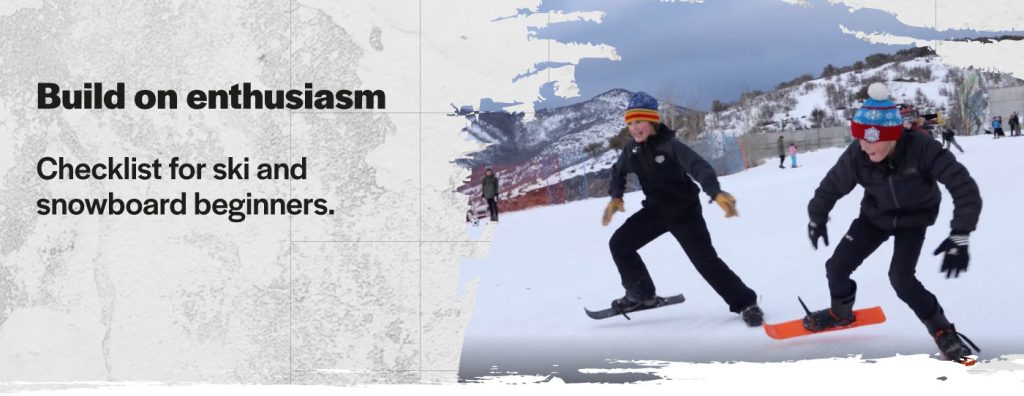Keen skiers normally can’t wait for their kids to hit the slopes!
Fact is, this is an expensive commitment. Unless you have an amazing mountain home, there won’t be many chances to practice either. Finally, the subzero temperatures: Sessions might have to be short even with the best apparel. You don’t have the luxury of long warm evenings!
Ski instruction for under-13s – physiology
Coaching children under the age of 13 is significantly different from adults.
- Their attention span is shorter. Their brain is still forming neural connections, spanning different thoughts and situations. Don’t expect to have their total attention for more than 10-15 minutes at a time.*
- Their physical development is not completed. Markedly lower hormonal levels mean that bones are softer and muscles are weaker than in an adult*. Plus, cardiovascular fitness is not capable of prolonged efforts, producing that “all-or-nothing” behaviour: One minute at full steam and soon after, exhaustion*.
- Last, but not least: even if you’d love to nurture the next alpine skiing world champion, do not make your kids work only on skiing. Variation is key to develop every motor skill necessary for your kids to mature all their faculties, both physical and mental.
Ski skills for all beginners – best practice
The Norwegian ski federation has switched its focus from formal coaching for beginners to ski play. They state that “The terrain takes the role of the coach. To achieve balance, repetition of movement speaks more than a thousand words.”
Good play terrain should offer challenges which the kids master, challenges which they dare try, and challenges they can aspire to. It should cater for jumping, racing, turning and forward gliding (similar to walking). They advise against poles for the first few seasons, and they recommend now and then having gos on one ski only, or skiing backwards down the slope – constantly mixing it up.
With this set-up, there will be a lot of falls… Learning to ski means falling. This is not wasted effort! It’s great for kids to watch adults being light-hearted, sharing in the fun and maybe falling themselves? It is a great muscular workout!
“Why do we fall? So we can learn to pick ourselves up” – Thomas Wayne
Back yard snow drills for a safe start
Here’s an old-school run-through of the basics before your kid takes their skills to the green slopes!
- Ploughing: the easiest way to learn to control speed for beginners. Plough turns (or wedge turns) are also the entry level of controlling direction.
- Stopping: at first, the plough stop. Apply the pressure on your inside edges – simultaneously! Once your kid has mastered parallel skiing, they are ready for the quicker and more powerful “hockey-stop”.
- Posture: Shoulders above toes, knees slightly bent. This will become intuitive. When turning, we all need our bodyweight over the “outer” ski – the ski nearest the valley as it were.
What are the best learner skis?
The key skill for a beginner (kid or adult) to get confident on skis is balance**. Roller-blading, ice-skating and gymnastics aren’t taught with poles, and ski federations and ski schools advise against it for the first few seasons. A client of mine, with a career as an alpine ski-instructor and a race competitor shared this advice with me: “I taught both my daughters how to ski without poles. Only after years, after they learned to balance, perform wedge turns, parallel turns, and then, only then, I bought them poles. They are for advanced skiers only”.

Short skis make it easier to get back up off the ground after inevitable falls. For stability, you can increase in width what they lose in length. Look for easy bindings with max flexibility. It allows shorter sessions, bathroom breaks, hot drinks….
Skis with metal edges are counter-productive for beginners and intermediates. Metal skis are stiffer, heavier and increase friction. Stick to simple play or training skis until the kids are ready for the finer techniques.
Finally, don’t forget why you love skiing so much yourself! Share the fun: there are safe ways for experienced skiers to let kids get a taste of the exhilaration of snow sports. You can buy a harness, or get closer still if you ski together in parallel. Use your adult ski pole as a shared bar for the two of you.
References
*Lloyd, S. R, Oliver, L. J. (2014) Strength and Conditioning for young athletes: science and applications. London: Routledge.
** Cigrovski V., Bozic I., Prlenda N. (2012) ‘Influence of motor abilities on learning of alpine ski technique.’ SportLogia, 8(2), 108-115
Further reading
Clelland M., Everett A. (2013) Ski tips for Kids. 1st edn. Guilford: Falcon Guides.
Malliou P., Amoutzas K., Theodosiu A., Gioftsidou A., Mantis K., Pylianidis T., Kioumourtzoglou E. (2004) ‘Proprioceptive training for learning downhill skiing.’ Perceptual and motor skills, 99, 149-154.
Caulfeild, V. (2014) How to ski – and how not to. 3rd edn. New York: Charles Scribner’s sons.






